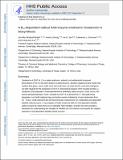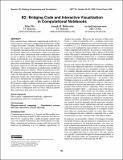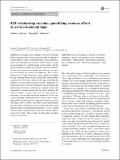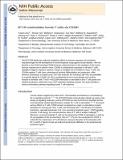Browsing MIT Open Access Articles by Title
Now showing items 3393-3412 of 55948
-
B Cells Promote Pancreatic Tumorigenesis
(American Association for Cancer Research (AACR), 2016-03)Summary: Three recent studies, approaching the question from different angles and using different and/or overlapping models, provide compelling evidence for the involvement of tumor-infiltrating B cells in the initiation ... -
B flavour tagging using charm decays at the LHCb experiment
(IOP Publishing, 2015-10-05)© CERN 2015. An algorithm is described for tagging the flavour content at production of neutral B mesons in the LHCb experiment. The algorithm exploits the correlation of the flavour of a B meson with the charge of a ... -
B flavour tagging using charm decays at the LHCb experiment
(IOP Publishing, 2015-10-05)© CERN 2015. An algorithm is described for tagging the flavour content at production of neutral B mesons in the LHCb experiment. The algorithm exploits the correlation of the flavour of a B meson with the charge of a ... -
B meson decays to charmless meson pairs containing η or η' mesons
(American Physical Society (APS), 2009-12)We present updated measurements of the branching fractions for B[superscript 0] meson decays to ηK[superscript 0], ηη, ηφ, ηω, η′K[superscript 0], η′η′, η′φ, and η′ω, and branching fractions and CP-violating charge asymmetries ... -
B-meson decays to eta′rho, eta′f0, and eta′K*
(American Physical Society, 2010-07)We present measurements of B-meson decays to the final states eta′rho, eta′f0, and eta′K*, where K* stands for a vector, scalar, or tensor strange meson. We observe a significant signal or evidence for eta′rho+ and all the ... -
A B12-dependent radical SAM enzyme involved in oxetanocin A biosynthesis
(Springer Nature, 2017-04)Oxetanocin A (OXT-A) is a potent antitumour, antiviral and antibacterial compound. Biosynthesis of OXT-A has been linked to a plasmid-borne Bacillus megaterium gene cluster that contains four genes: oxsA, oxsB, oxrA and ... -
B2: Bridging code and interactive visualization in computational notebooks
(ACM, 2020)© 2020 Owner/Author. Data scientists have embraced computational notebooks to author analysis code and accompanying visualizations within a single document. Currently, although these media may be interleaved, they remain ... -
B2B relationship calculus: quantifying resource effects in service-dominant logic
(Springer Nature, 2015-12)Increasingly, knowledgeable business-to-business (B2B) customers and evolving customer needs are leading to seismic shifts in vendor–client interactions. Across industries, sellers are changing their business models from ... -
B7-H5 costimulates human T cells via CD28H
(Nature Publishing Group, 2013-06)The B7/CD28 family has profound modulatory effects in immune responses and constitutes an important target for the development of novel therapeutic drugs against human diseases. Here we describe a new CD28 homologue (CD28H) ... -
B[superscript 0] meson decays to ρ[superscript 0]K[superscript *0], f[subscript 0]K[superscript *0], and ρ[superscript -]K[superscript *+], including higher K[superscript *] resonances
(American Physical Society, 2012-04)We present branching fraction measurements for the decays B[superscript 0]→ρ[superscript 0]K[superscript *0], B[superscript 0]→f[subscript 0]K[superscript *0], and B[superscript 0]→ρ[superscript -]K[superscript *+], where ... -
The BaBar detector: Upgrades, operation and performance
(Elsevier BV, 2013-06)The BaBar detector operated successfully at the PEP-II asymmetric e⁺e⁻ collider at the SLAC National Accelerator Laboratory from 1999 to 2008. This report covers upgrades, operation, and performance of the collider and the ... -
Babel Storage: Uncoordinated Content Delivery from Multiple Coded Storage Systems
(Institute of Electrical and Electronics Engineers (IEEE), 2020-02)In future content-centric networks, content is identified independently of its location. From an end-user's perspective, individual storage systems dissolve into a seemingly omnipresent structureless 'storage fog'. Content ... -
BACE-1 inhibition facilitates the transition from homeostatic microglia to DAM-1
(American Association for the Advancement of Science (AAAS), 2022-06-17)<jats:p> BACE-1 is required for generating β-amyloid (Aβ) peptides in Alzheimer’s disease (AD). Here, we report that microglial BACE-1 regulates the transition of homeostatic to stage 1 disease-associated ... -
Bacillus subtilis Class Ib Ribonucleotide Reductase Is a Dimanganese(III)-Tyrosyl Radical Enzyme
(American Chemical Society (ACS), 2011-05)Bacillus subtilis class Ib ribonucleotide reductase (RNR) catalyzes the conversion of nucleotides to deoxynucleotides, providing the building blocks for DNA replication and repair. It is composed of two proteins: α (NrdE) ... -
Bacillus Subtilis Class Ib Ribonucleotide Reductase: High Activity and Dynamic Subunit Interactions
(American Chemical Society (ACS), 2014-01)The class Ib ribonucleotide reductase (RNR) isolated from Bacillus subtilis was recently purified as a 1:1 ratio of NrdE (α) and NrdF (β) subunits and determined to have a dimanganic-tyrosyl radical (Mn[superscript ... -
The Bacillus subtilis conjugative transposon ICEBs1 mobilizes plasmids lacking dedicated mobilization functions
(American Society for Microbiology, 2012-04)Integrative and conjugative elements (ICEs, also known as conjugative transposons) are mobile elements that are found integrated in a host genome and can excise and transfer to recipient cells via conjugation. ICEs and ... -
Bacillus Subtilis SMC Complexes Juxtapose Chromosome Arms as They Travel from Origin to Terminus
(American Association for the Advancement of Science (AAAS), 2017-02)Structural maintenance of chromosomes (SMC) complexes play critical roles in chromosome dynamics in virtually all organisms, but how they function remains poorly understood. In the bacterium Bacillus subtilis, SMC-condensin ... -
Back pressure effect on three-way catalyst light-off
(Professional Engineering Pub., 2018-06-01)The effect of back pressure on the light-off of a modern spark ignition engine 3-way catalyst has been assessed by measuring The effect of back pressure on the light-off of a modern spark ignition engine 3-way catalyst ... -
Back Story: Migration, Assimilation and Invasion in the Nineteenth Century [book chapter]
(2014)Research from a humanist perspective has much to offer in interrogating the social and cultural ramifications of invasion ecologies. The impossibility of securing national boundaries against accidental transfer and the ... -
Back to the Basics of SARS-CoV-2 Biochemistry: Microvascular Occlusive Glycan Bindings Govern Its Morbidities and Inform Therapeutic Responses
(MDPI AG, 2024-04-22)Consistent with the biochemistry of coronaviruses as well established over decades, SARS-CoV-2 makes its initial attachment to host cells through the binding of its spike protein (SP) to sialylated glycans (containing the ...




















